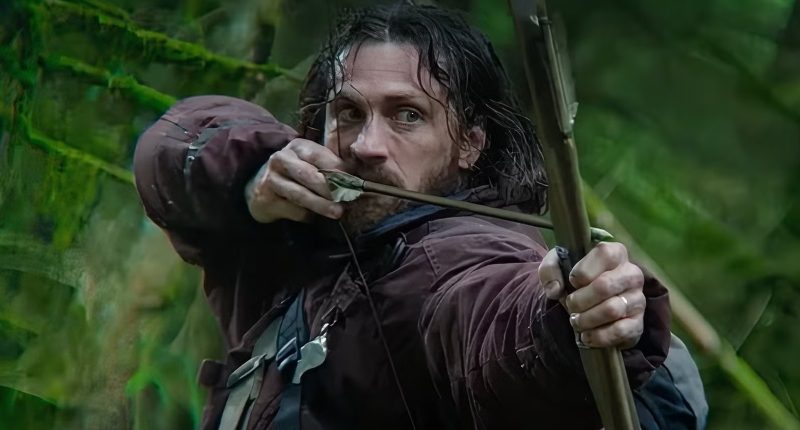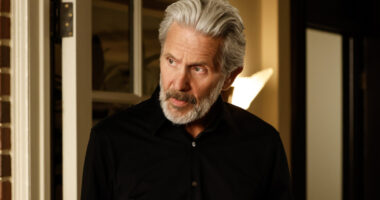Share this @internewscast.com
Contains spoilers for “28 Years Later”
“28 Days Later” is a renowned horror film that many on Reddit consider the greatest zombie movie ever made. Although the infected aren’t exactly traditional zombies, the film certainly stakes a strong claim to that title. It weaves a gripping tale of the aftermath following a rage virus outbreak in Great Britain. The continuation, “28 Weeks Later,” maintained the momentum, and fans have eagerly anticipated “28 Years Later,” which explores a world enduring the chaos inflicted by the infected decades later.
Was the wait worthwhile? Opinions vary widely, as the third installment has sparked division among viewers. Looper’s review of “28 Years Later” applauded the cinematography and the story’s grim tone. Nonetheless, it lost a point for its unsettling final scene, which appears to be a major point of contention. Social media is abuzz with debates about the film’s strengths and weaknesses. Critics awarded it an 89% positive rating on Rotten Tomatoes at the time of writing, in contrast to the general audience score of 65%.
Debates like these are a thrilling aspect of being a movie enthusiast. Viewers can watch the same film and emerge with strikingly different perspectives. Some feel that “28 Years Later” deserves a spot on the list of the best zombie movies of the 21st century, while others found it disappointingly lacking. Let’s delve into the conclusion of “28 Years Later,” particularly the last scenes, to uncover what might be causing such controversy. Understanding these elements could offer fresh insights into the film or, at the very least, illuminate expectations for the next installment, “28 Years Later: The Bone Temple.”
What you need to remember about the plot of 28 Years Later
28 years following the outbreak of the rage virus, the British Isles remain under quarantine and some infected continue to roam. Off from the mainland exists an island village, and one day, Jamie (Aaron Taylor-Johnson) takes his 12-year-old son, Spike (Alfie Williams), to the mainland to hunt the infected as part of a coming-of-age ritual. They barely make it out alive, but while on the mainland, Spike sees a fire and learns after the fact that Dr. Ian Kelson (Ralph Fiennes) is out there. Spike believes Dr. Kelson could help his ailing mother, who’s prone to headaches and forgetfulness. No one else knows what’s wrong with her, but Spike hopes a real doctor could aid her.
Spike sneaks his mother, Isla (Jodie Comer), out of the village and back onto the mainland. During one attack by infected, the pair get saved by Erik (Edvin Ryding), a Swedish NATO soldier whose unit got washed ashore after their ship sank, but he’s the sole survivor. They also encounter a pregnant infected woman who gives birth to a baby that doesn’t have the virus. Erik and Isla meet Dr. Kelson, who’s been living amongst the infected for a long time. He’s able to incapacitate them using morphine-laced darts. Kelson leads them to his sanctuary, which includes pillars of human skulls.
What happened at the end of 28 Years Later?
Dr. Kelson diagnoses Isla with terminal cancer that has spread to her brain. With no hope for a cure, Kelson incapacitates Spike, who stays with the baby, while he gives Isla a merciful death on her own terms. Dr. Kelson imparts two phrases onto Spike: “Memento mori” and “Memento amoris,” roughly meaning “Remember, you must die” and “Remember, you must love,” respectively. It brings home the film’s themes that even in a bleak world, beauty and hope can still exist. After Dr. Kelson euthanizes Isla, he brings her skull back to Spike, who places it at the very top of Kelson’s skull tower.
Spike then takes the baby, whom he’s named Isla, back to his island village, but he doesn’t stay with her. Instead, he leaves a note saying how the baby was born of an infected, but she’s fine. As for him, he’ll remain on the mainland, forging a new identity for himself outside of his father’s influence. The film then jumps ahead 28 days into the future when Spike gets attacked by a horde of infected.
Spike runs away but encounters a massive barrier. Just when it seems like all hope is lost, a man by the name of Jimmy (Jack O’Connell) shows up and offers help. He has a band of other Jimmies, who lay waste to the infected with some epic, parkour-infused, Power Rangers-esque fight moves. Jimmy offers Spike a place in his gang, which Spike accepts. But, as we’ll dig into, there are some very good reasons why Spike should be worried about his newfound allies.
Who is Jimmy at the end of 28 Years Later?
Jimmy’s entrance at the end of “28 Years Later” is a full circle moment from where the film begins. “28 Years Later” opens with a scene of some kids watching “Teletubbies.” Among them is a blonde-haired boy whom a woman refers to as “Jimmy.” Viewers can infer that Jack O’Connell’s character at the end of the film is this little boy all grown up, something director Danny Boyle has confirmed to be the case.
Unfortunately, the rage virus infects adults in the building, who attack the children. Jimmy escapes and goes to a church where his father, a vicar, is present. Instead of trying to protect his son, the vicar gives him a crucifix necklace and tells him to get away because he actively wants to be eaten by the infected. If you look closely, adult Jimmy still wears the necklace, but the cross is hanging upside down, likely indicating how he probably isn’t living by the church’s teachings these days.
He may save Spike’s life, but there’s something undeniably twisted about Jimmy and his cohorts. And those familiar with British pop culture know there’s a good reason for that.
Why do the Jimmies look like that?
The following slide contains references to sexual assault.
Jimmy might literally be named Jimmy, but he has a gang of other Jimmies with him, such as Erin Kellyman’s Jimmy Ink and Emma Laird’s Jimmima. They all sport bleach-blonde hair and colorful tracksuits, making them look like disgraced media personality and DJ Jimmy Savile. Savile was a British radio disc jockey throughout the 1970s and ’80s, and he became the host of various children’s programs, like “Play It Safe,” where he points out potential dangers kids might encounter in homes. He was a beloved figure throughout his life and died in 2011. A year after his death, hundreds of victims came forward to allege that Savile sexually abused them. Many of these victims were minors at the time the abuse took place.
It seems odd to reference such a horrific atrocity in a zombie movie, but Jimmy idolizing Savile could make sense in the larger context of the film. The rage virus outbreak occurred in 2002. That means England wouldn’t have reckoned with the Savile allegations if mostly everyone in the country was overtaken by this disease. Jimmy probably views television as a safety net, considering he’s plopped in front of the TV while the adults try to handle the infected situation. If he watched “Teletubbies,” he probably knew who Jimmy Savile was and looked up to him.
When asked about this by Business Insider, director Danny Boyle confirmed that Jimmy and his cult are indeed inspired by Savile, and he explained why they did this. “It’s all kind of twisting in this partial remembrance, clinging onto things and then recreating them as an image for followers.” Screenwriter Alex Garland also chipped in, saying of O’Connell’s character, “He’s a kaleidoscope, isn’t he? A sort of trippy, f***ed up kaleidoscope.”
If you or anyone you know has been a victim of sexual assault, help is available. Visit the Rape, Abuse & Incest National Network website or contact RAINN’s National Helpline at 1-800-656-HOPE (4673).
What does the ending of 28 Years Later mean thematically?
“28 Years Later” examines what it means to grow up in a world in constant turmoil and filled with violence. Spike sees that with his own father, who cheats on his wife and lashes out violently when Spike disobeys him. The kids on the island are made to go to the mainland to kill the infected, a needless ritual given the risk involved. This is no doubt why Spike leaves the village and his father at the end of the film; he wants to find another way and forge his own identity. That might be a fool’s errand, because Spike runs into the Jimmy gang at the end of the film.
Jimmy saves his life, so Spike probably feels indebted to him. But given the sheer amount of glee they exhibit in killing infected, there’s clearly a darker angle to the gang that’ll be explored in the sequel. We already know there’s darkness given the allusion to Jimmy Savile, even if the film’s characters aren’t aware of Savile’s horrific crimes. The final moments of the film remind us that the grass isn’t always greener on the other side. They also raise questions about Spike’s coming-of-age story: Is he mature enough to see Jimmy for what he is, or will he eagerly join his ranks? On the whole, “28 Years Later” is a film about family and loss, but the end is about temptation.
What does the baby mean for the future of the franchise?
“28 Years Later” is incredibly bleak, yet it’s also strangely hopeful. This goes back to the dual phrases Dr. Kelson taught Spike — “Memento mori” and “Memento amoris.” On the flip side of all the darkness, there are glimmers of hope in this world, a prime example being the baby, Isla, born of an infected mother. Dr. Kelson credits this to the miracle of the placenta, and it tells us there’s still hope in this world. The infected are a tragedy, yet the baby could have an absolutely normal life, meaning once the current crop of infected go away, theoretically, the world will be fine.
The baby also reminds us that there’s still humanity within the infected. As the mother gave birth, she didn’t attack Isla. The infected may not be the mindless automatons so many consider them to be. And that’s huge for the franchise going forward, as Jodie Comer explained to ComicBook.com, “That moment to me, I think to all of us, feels so profound and I think is probably going to indicate a huge shift or introduction of something going forward. You know, that there’s this, this baby that is uninfected and provides this element of hope.” There may be darkness in this world, whether it’s in the form of toxic masculinity or cults, but there’s also beauty. Everyone dies eventually, though in the meantime, it’s important for us all to love.
What does the ending of 28 Years Later mean for 28 Years Later: The Bone Temple?
“28 Years Later” kickstarts a brand new trilogy that will continue with “28 Years Later: The Bone Temple,” one of several movies primed to blow you away in 2026. The quick turnaround is all thanks to “28 Years Later” and “The Bone Temple” filming at the same time, so fans won’t have to wait long to see how this story resolves itself.
“The Bone Temple” will bring back Alfie Williams as Spike, and it should explore more of his newfound affiliation with the Jimmy gang. Plot details are sparse, but if we can venture a guess, it may be about Spike coming into the Jimmy fold before learning how depraved they all truly are. And if there’s humanity still left in the infected, the Jimmies probably wouldn’t care, while Spike may be more interested in saving them. Ralph Fiennes, who will also return, said as much in an interview with Entertainment Weekly: “The theme of innate humanity — is it still alive in the soul, in the heart, in the mind of an infected person? Are they completely corrupted? Are they only rabid? Or is there the possibility of something? Something human, it’s still there.”
Cillian Murphy, who played Jim in “28 Days Later,” will also factor into “The Bone Temple,” although Danny Boyle may have spoiled how much of Murphy we’ll see. He told ScreenRant, “Cillian will be a huge part of the third movie having been introduced in what is, in effect, a coda to the second movie.” It sounds like Jim will be teased in “The Bone Temple” like how Jimmy was teased at the end of “28 Years Later,” only to grow in prominence later.
What has director Danny Boyle said about the ending of 28 Years Later?
“28 Years Later” could have one of the most shocking movie endings of all time, as it presents a complete tonal shift and introduces a roving gang based on an infamous sexual abuser. For director Danny Boyle, it was a worthwhile ending for precisely how disorienting it is and what it sets up for the future. “It is shocking. It returns you to the fact this is a horror film but not in a way you might be expecting. They go on to dominate the second film,” Boyle said to BAFTA (via LAD Bible). “I thought, ‘This is the most original piece of writing I’ve seen since ‘Clockwork Orange.'”
One truth about “A Clockwork Orange” is that it’s been wildly influential in cinema, and you can definitely see the inspirations within “28 Years Later.” Both films introduce a roving band of thugs who take pleasure in inflicting harm, with the only difference that the Jimmies have some level of disconnect killing individuals who are, for all intents and purposes, mindless zombies. The ending of “28 Years Later” reminds audiences that there’s more than one type of horror. There’s the horror of the infected and the very different horror inflicted by humans.
According to Danny Boyle, this idea will be at the heart of “The Bone Temple.” He told The Independent: “I asked Alex [Garland] right at the beginning to just tell me what’s the nature of each of the films, and he said that the nature of the first film is about family. The second film is about the nature of evil. And you’re about to meet a lot more of them when it’ll be more appropriate to talk about them in the second film.”
Is there an alternate ending of 28 Years Later?
No one can say Danny Boyle and screenwriter Alex Garland didn’t swing for the fences with the ending to “28 Years Later,” but it wasn’t always going to end that way. When Garland and Boyle spoke with ScreenRant, they admitted that there was an earlier version with a finale that was “too generic.” Garland confirmed that the ending they ultimately went with was his idea. “There was a version that we worked on before, there was another writer who wrote a script, and then I did what was in effect, a kind of rewrite of that script. Jimmy didn’t feature in that story at all,” he said.”
He didn’t specify what the generic ending was but continued stating how he wanted to get more subversive with this sequel. Suffice it to say, no one who went to see the movie in theaters was expecting that ending. Knowing that a sequel was guaranteed undoubtedly helped them push forward with something more off-the-wall. It was a gamble that paid off right out of the gate, as “28 Years Later” grossed $60 million globally in its opening weekend, outperforming the projections. No doubt plenty of moviegoers will want to see how Spike gets along with the Jimmies when “28 Years Later: The Bone Temple” comes out in January 2026, one of many upcoming horror sequels currently being made.







